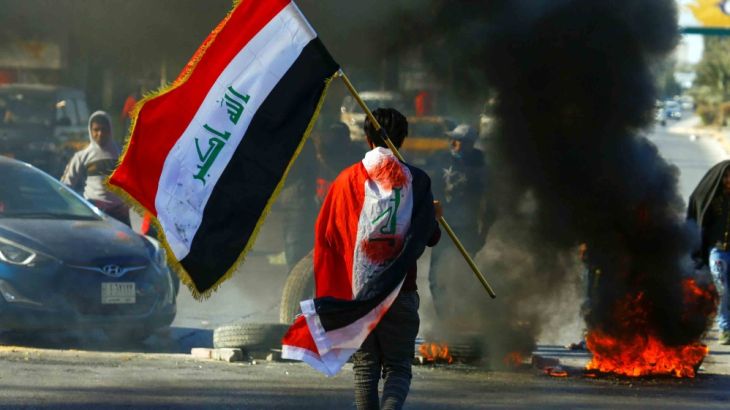Iraq’s Shia armed groups meet over ‘US aggression’: Spokesman
Spokesman of Iran-linked Kataib Hezbollah group says meeting took place with Iraq’s Shia leader Muqtada al-Sadr.

The leaders of major Shia armed groups in Iraq gathered in Iran’s city of Qom earlier this month to coordinate efforts to expel the United States‘ troops in Iraq.
Mohammad Mohie, spokesman of the Iran-backed Shia paramilitary group Kataib Hezbollah, told Al Jazeera on Sunday that the meeting held on January 13 aimed to coordinate future action among the armed groups.
Keep reading
list of 2 itemsIraq protests: Taking on the establishment, fighting to be heard
“That meeting was very important to coordinate our actions, activities and the resistance for the next step,” Mohie said.
More:
“The Americans may stay in Iraq and challenge us, so we are coordinating among ourselves,” he said, adding that populist Shia leader, Muqtada al-Sadr, who leads the Sairoon bloc in parliament and lives in Qom, had called the meeting.
It also included Asaib Ahl al-Haq, the Shia armed group led by Qais al-Khazali, who was blacklisted by the US over his alleged role in the killings of demonstrators in Iraq.
‘Beginning of new era’
“We responded to Muqtada al-Sadr’s call … and one of the outcomes [of the meeting] is the protest which will take place in four to five days,” said Mohie.
“This is the beginning of the new era of coordination between Shia forces and resistance groups,” he added.
The Iraqi Parliament responded to recent escalations between the US and Iran on Iraqi soil by voting on January 5 in favour of a resolution calling on the government to expel foreign troops from the country.
The resolution also called for cancelling Baghdad’s request for assistance from the US-led coalition which had been working with Baghdad to fight the ISIL (also known as ISIS).
Days after the Parliament’s vote to expel foreign troops from Iraq, Sadr called on January 14 for a “million-man march” against the presence of US troops in Iraq.
“The skies, land and sovereignty of Iraq are being violated every day by occupying forces,” Sadr wrote on Twitter. The march is expected to take place on Friday.
US-Iran tensions
These developments date back to December 30 when the US carried out attacks on the Kataib Hezbollah positions in Iraq and Syria, killing at least 25 fighters of the armed group.
The US attack was in response to the killing of an American civilian contractor two days earlier.
Mohie rejected the US claims, saying that Kataib Hezbollah was not behind the attack on a base in Kirkuk which led to the US contractor’s death.
“The US government came up with these allegations in order to attack Kataib Hezbollah. The attacks happened without any provocation against the US or even the coalition,” he told Al Jazeera.
“They want to push the PMF [Popular Mobilisation Forces] out of this area. What happened in Kirkuk was the Americans trying to create this allegation and they succeeded in attacking our forces fighting against ISIL.”
Supporters and members of Kataib Hezbollah and other paramilitary groups within the Hashd al-Shaabi (Popular Mobilisation Forces or PMF), an umbrella organisation of mostly Iran-backed Shia armed groups, responded by storming the US embassy in Baghdad.
On January 3, the US assassinated leader of Iran’s elite Quds Force, General Qassem Soleimani, and PMF’s deputy head, Abu Mahdi al-Muhandis, near Baghdad airport in an air attack ordered by President Donald Trump.
Soleimani’s assassination pushed the US and Iran to the brink of war, but fears of an all-out conflict eased when retaliatory Iranian raids aimed at US troops in Iraq on January 8 concluded without any fatalities.
|
|